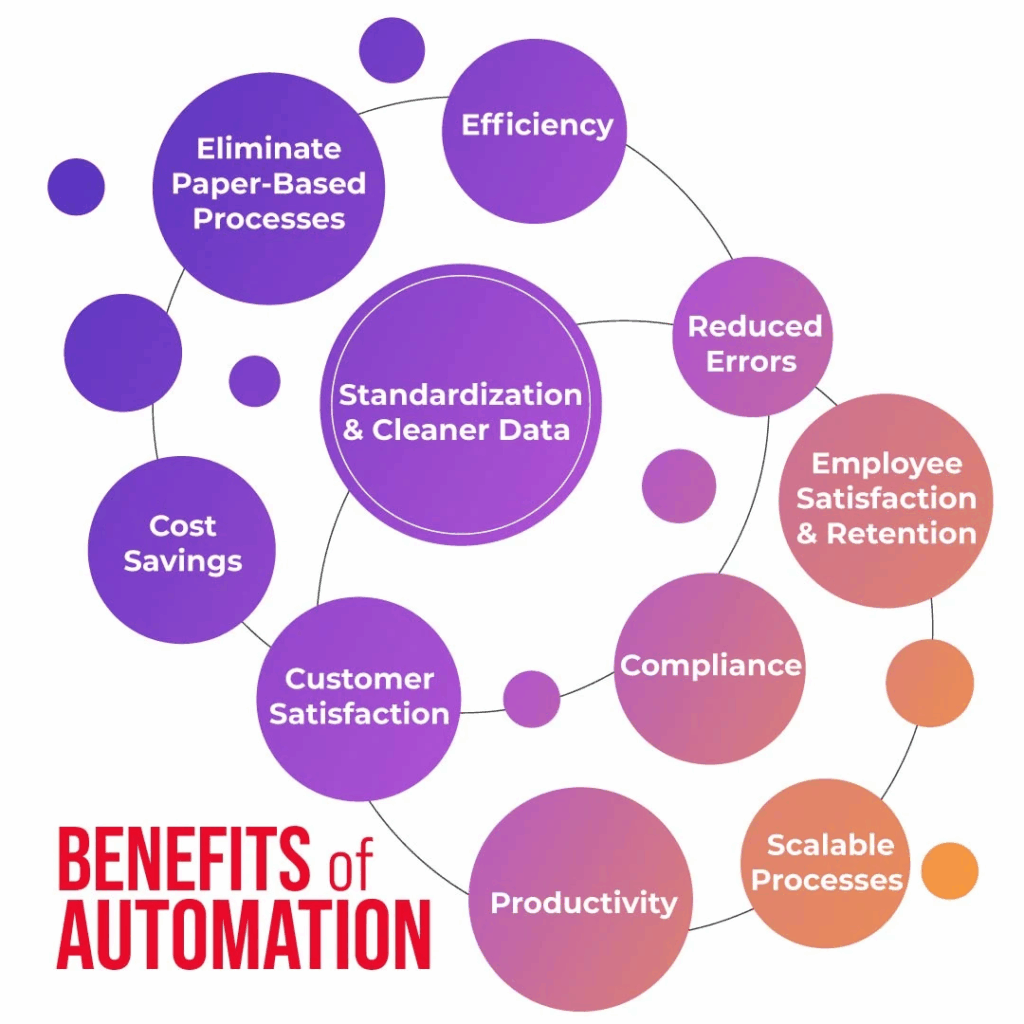
Key Takeaways
- Workflow automation streamlines repetitive tasks, freeing up valuable resources.
- Automation significantly reduces operational costs by minimizing manual labor and errors (saving 1-3% of earnings from error reduction alone).
- Productivity skyrockets with automated systems working 24/7 and completing tasks 3-5 times faster than manual methods.
- Strategic benefits include enhanced decision-making, improved scalability (2-3x faster scaling), and higher employee satisfaction (25-30% higher job satisfaction).
- Automation offers a high Return on Investment (ROI), often averaging around 240%, driven by cost savings and efficiency gains.
- It’s crucial for small businesses (SMBs), enabling them to compete effectively by handling large volumes and improving customer service with limited resources.
Are your teams bogged down by repetitive data entry? Are manual processes creating bottlenecks and slowing growth? You’re not alone. Many businesses struggle with tasks that take up too much time and effort.
There’s a powerful solution: workflow automation. Simply put, workflow automation uses technology to streamline and run sequences of tasks that people used to do by hand. It moves information automatically from one step to the next in a business process, like passing a digital baton.
This post explores the significant benefits of automating business processes. We’ll explain how adopting automation can completely change how your business operates, making things run smoother and faster. Understanding why workflow automation matters is key for any business wanting to succeed and grow in today’s fast-moving digital world. Let’s dive into how automation can unlock potential and drive real results.
Slash Costs and Reclaim Time: How Automation Saves Time and Money
One of the most immediate and powerful impacts of switching to automated systems is how automation saves time and money. Manual, repetitive tasks eat up valuable resources.
Think about tasks like processing invoices or entering customer data by hand. These aren’t just slow; they are expensive. Simple human mistakes during these tasks can cost businesses between 1% and 3% of their total earnings each year. That’s a lot of money lost to preventable errors!
Automation changes the game entirely when it comes to speed. Systems designed for business process automation work much faster than people can for routine jobs. Studies show that automated processes can complete tasks 3 to 5 times faster than doing them manually. Imagine getting work done in hours instead of days.
This speed directly leads to cost savings, especially regarding labor. Automated workflows need much less human input for administrative chores. This means companies can reduce the staff hours spent on these tasks by 30% to 50%. This doesn’t always mean cutting jobs. Often, it means freeing up your team members to focus on bigger goals, like strategy or customer interaction, instead of tedious paperwork.
Automation is also brilliant at cutting down mistakes, particularly in finance. When you automate things like payments and financial reporting, you drastically lower the chance of costly errors. It also helps reduce the risks linked to not following rules and regulations, which can lead to big fines. Fewer errors mean less money wasted and better compliance.
What happens to all the time saved? It gets put to better use. By automating routine work, businesses can move their employees’ time (often measured in Full-Time Equivalents or FTEs) away from low-value activities. Instead, staff can focus on tasks that generate revenue, improve customer relationships, or develop new ideas – the strategic work that truly grows a company.
These savings are especially important for smaller operations. For small businesses, the ability to reduce manual tasks in small business environments through automation is huge. Take payroll and HR, read more . Automating these functions can save a small business 15 to 20 hours every single month just on tasks related to staying compliant with rules. This frees up critical time and money, which are often scarce in smaller companies. This ability to save resources is one of the core benefits of automating business processes for Small and Medium Businesses (SMBs).
Supercharge Your Operations: Increase Productivity with Automation
Beyond just saving money, automation is a powerful tool to increase productivity with automation. It helps your business get more done, faster, and with better consistency.
Automated systems, like robotic process automation (RPA) bots, don’t need coffee breaks, sleep, or vacations. They can work around the clock, 24 hours a day, 7 days a week, without stopping. This continuous operation dramatically increases the amount of work that can be processed, known as throughput. This is especially helpful for customer-facing operations. Think about automated customer support chatbots answering queries instantly, or order fulfillment systems processing sales day and night. Zero downtime means maximum output.
Many business processes involve multiple steps and waiting for approvals. Manual handoffs between steps can cause significant delays. Automation streamlines these workflows. For instance, automated approval processes, where documents or requests are automatically routed to the right person, can slash project or process cycle times by a remarkable 40% to 60%. This means projects finish faster, and decisions are made more quickly.
Automation also optimizes how you use your human talent. It frees employees from boring, repetitive tasks. Studies show that staff in automated environments can spend up to 70% less time stuck doing low-value work. This doesn’t make employees redundant; it makes them more valuable. They can shift their focus to more complex problems, strategic thinking, creative solutions, and engaging directly with customers – activities that require human skills and contribute more significantly to the business’s success.
Furthermore, as routine tasks get handled by technology, employees gain opportunities to grow. They can be retrained to develop higher-value skills. Instead of data entry, they might learn data analysis to understand business trends. Instead of manually checking forms, they might learn process improvement techniques or how to manage the automation system itself, handling exceptions that require human judgment. This upskilling benefits both the employee and the company.
Finally, automation brings incredible consistency and improves quality. Automated processes perform tasks exactly the same way every single time they run. This standardization eliminates the variability that comes with manual work. The result is uniform output quality, predictable results, and much easier management of compliance requirements across different teams and departments. Everyone follows the same digital playbook.
Beyond Efficiency: Strategic Advantages and the ROI of Workflow Automation Tools
While saving time and money are major draws, the true power of automation goes much further. Understanding why workflow automation matters involves looking at its strategic advantages and the significant ROI of workflow automation tools. Automation isn’t just about doing things faster; it’s about positioning your business for long-term success.
The advantages of implementing workflow automation extend far beyond immediate cost reductions and efficiency gains. Automation acts as a strategic tool, helping businesses become more agile, competitive, and prepared for growth.
One key strategic benefit is enhanced decision-making and agility. Automation systems often gather data as they operate. This provides businesses with real-time insights into their processes and performance. Having access to up-to-the-minute data allows leaders to make faster, more informed decisions. This ability to react quickly to market changes or internal issues gives automated businesses a distinct competitive edge. This growing reliance on automation for agility is clear in market trends: the adoption of digital process automation tools has been growing by 21% every year since 2019.
Scalability is another crucial strategic advantage. Businesses that rely heavily on manual processes often struggle to cope with sudden growth or increased demand. Hiring and training new staff takes time and resources. Automated businesses, however, are much better equipped to scale. Automated systems can handle significantly increased workloads without proportional increases in cost or complexity. Analysis indicates that businesses with strong automation foundations can typically scale their operations 2 to 3 times faster during expansion periods compared to their manually-driven competitors. This means they can seize growth opportunities more effectively.
Automation also has a surprising but significant impact on your workforce: improved employee experience. Nobody enjoys spending their day on tedious, mind-numbing tasks. By automating these repetitive parts of the job, you remove major sources of frustration and boredom for your employees. This leads to higher morale and job satisfaction. In fact, departments that have implemented higher levels of automation report 25-30% higher job satisfaction rates among employees and see a noticeable reduction in burnout. Happier employees are typically more productive and loyal.
Calculating the ROI of Workflow Automation Tools
To truly understand the value, let’s look at the Return on Investment (ROI). ROI measures how profitable your investment in automation technology is. It simply compares the financial gains you get (like cost savings and potential revenue increases) against the costs you incur (like software licenses, implementation services, and employee training).
Several key factors drive the impressive ROI seen with workflow automation tools:
- Significant Labor Cost Reductions: As mentioned earlier, automation can reduce the need for manual hours on administrative tasks by 30-50%. This translates directly into substantial payroll savings or allows for reallocation of staff to more valuable roles.
- Dramatic Decreases in Error Rates: Automation nearly eliminates human error in rule-based tasks. Businesses report decreases in error rates by an astounding 60-80% in automated processes, avoiding costly mistakes and rework.
- Considerable Compliance Cost Savings: Fewer errors and standardized, documented processes make audits easier and reduce the risk of non-compliance penalties. This results in compliance-related cost savings of 25-40%.
When you combine these powerful impacts, the financial return becomes clear. It’s not surprising that businesses, on average, report a remarkable ROI of 240% from their investments in automation technology.
Therefore, investing in the right ROI of workflow automation tools should not be viewed as a mere expense. It is a strategic investment that pays back dividends through increased efficiency, reduced costs, improved quality, enhanced scalability, and happier employees. The returns are measurable and often substantial, making automation a wise choice for future-focused businesses.
Leveling the Playing Field: How Automation Helps Reduce Manual Tasks in Small Business
Workflow automation isn’t just for large corporations with huge budgets. It’s increasingly becoming a game-changer for smaller companies too, acting as a powerful way to reduce manual tasks in small business operations and compete effectively.
For small and medium-sized businesses (SMBs), resources like time and staff are often limited. Workflow automation acts as a force multiplier. It allows small teams to achieve levels of efficiency and output that were previously only possible for much larger organizations. This is especially critical when you need to make the most of every employee’s time.
Consider handling large volumes of work. Manual processes can quickly overwhelm a small team. Automation enables even very small teams, sometimes fewer than five employees, to manage high transaction volumes smoothly. This could mean processing hundreds or thousands of customer orders, supplier invoices, or support requests without needing a large administrative department. They can handle enterprise-level workloads without the enterprise-level headcount.
Automation also helps SMBs compete effectively on customer service. Larger competitors might have big support teams, but automation can level the playing field. Tools like automated email responses, chatbot support for common questions, and automated ticketing systems ensure that customer inquiries are acknowledged and routed quickly, even outside of standard business hours. This leads to faster response times and a better customer experience, helping SMBs build loyalty and a strong reputation.
Another significant benefit is access to data and insights. Traditionally, deep business analytics required dedicated analysts and expensive software, putting it out of reach for many SMBs. However, many modern automation platforms come with built-in reporting and analytics dashboards. This gives small business owners easy access to key performance indicators (KPIs), process efficiency data, and trends. These insights enable data-driven decision-making, helping SMBs optimize operations and identify new opportunities just like their larger counterparts.
So, how can small businesses get started and successfully reduce manual tasks in small business environments? Here are some practical strategies:
- Choose User-Friendly Tools: Look for automation platforms described as “low-code” or “no-code.” These tools often use drag-and-drop interfaces and require minimal technical expertise or IT support to set up and manage. This makes automation accessible even without a dedicated IT department.
- Start Small, Think Big: Don’t try to automate everything at once. Adopt a phased approach. Identify the tasks that are most repetitive, high-volume, and prone to errors – things like invoice processing, data entry between systems, or standard report generation. Automating these first will provide quick wins and build momentum.
- Measure Your Success: Before you automate a process, understand its current performance. Track metrics like how long it takes (cycle time), how often errors occur, and the cost associated with it. After implementing automation, track these same metrics again. Comparing the “before” and “after” clearly demonstrates the value of the automation and helps justify further investment.
By leveraging automation strategically, small businesses can overcome resource limitations, operate more efficiently, provide better service, and make smarter decisions, truly leveling the playing field.
(Sources)
Conclusion: Embracing Automation for Future Success
As we’ve explored throughout this post, the benefits of automating business processes are wide-ranging and deeply impactful. They move far beyond simple task completion. We’ve seen clear evidence of how automation saves time and money through reduced errors and optimized labor. We’ve also seen its power to increase productivity with automation by enabling 24/7 operations and faster process cycles.
Ultimately, why workflow automation matters becomes crystal clear when you consider the strategic advantages. It boosts scalability, allowing businesses to grow without being hampered by manual limitations. It improves employee satisfaction by removing tedious work, leading to a more engaged workforce. It delivers a strong financial return, making the ROI of workflow automation tools a compelling factor. And importantly, it empowers smaller companies, helping to reduce manual tasks in small business and enabling them to compete more effectively.
In today’s fast-paced and competitive business environment, clinging to outdated manual processes is a significant risk. Delaying the adoption of automation means potentially falling behind competitors in operational agility, cost-effectiveness, and the ability to adapt to market demands. Embracing workflow automation is no longer just an option for improvement; it’s becoming essential for sustainable growth and future success.
(Sources)
Ready to Automate? Take the Next Step
Ready to unlock growth and explore the benefits of automating business processes for your specific needs? The journey starts now.
Consider the future: solutions are increasingly incorporating Artificial Intelligence (AI) for even smarter automation, providing predictive insights to guide decisions. Tools are also evolving to better support the growing hybrid workforce, facilitating seamless collaboration between humans and automated systems. Industry-specific automation packages are also becoming more common, offering tailored solutions for unique sector challenges.
Here are some concrete steps you can take:
- Explore [Your Company’s] workflow automation solutions today. See how our tools are designed to streamline your operations.
- Use an assessment framework, perhaps similar to the concept offered by Rippling, to pinpoint the processes in your business with the highest potential for automation impact.
- Download our implementation checklist, inspired by resources like FlowForma’s, to guide you through the initial planning stages.
- Contact us for a personalized demo to see exactly how automation saves time and money and boosts efficiency for businesses just like yours.
Don’t wait for the future of work – start building it today with workflow automation.
(Sources)
Frequently Asked Questions
1. What exactly is workflow automation?
Workflow automation is the use of technology (software) to design, execute, and manage sequences of tasks that make up a business process. Instead of manually passing information or tasks from one person or step to the next, the software handles these handoffs automatically, reducing delays and errors.
2. Is automation expensive? What’s the typical ROI?
While there is an initial investment in software and potentially implementation, automation often pays for itself quickly. Key benefits include reduced labor costs (30-50% less time on admin tasks), fewer costly errors (60-80% reduction), and improved compliance. On average, businesses report an ROI of around 240% from automation investments.
3. Will automation replace human jobs?
Automation primarily targets repetitive, rule-based tasks. While it reduces the need for manual labor on these specific tasks, it often frees up employees to focus on higher-value activities like strategic thinking, customer interaction, problem-solving, and managing the automation itself. Many companies see it as a way to enhance employee roles and satisfaction, not eliminate them.
4. Can small businesses benefit from automation?
Absolutely. Automation is a powerful tool for SMBs, allowing them to achieve high efficiency and handle large volumes with small teams. User-friendly “no-code” or “low-code” platforms make it accessible without extensive IT resources. It helps SMBs save critical time and money, improve customer service, and make better decisions, leveling the playing field with larger competitors.
5. Where should I start with automating processes?
Start by identifying processes that are highly repetitive, high-volume, time-consuming, and prone to manual error. Good candidates often include invoice processing, data entry, employee onboarding, customer support ticketing, or report generation. Begin with one or two processes to gain experience and demonstrate quick wins before expanding.


